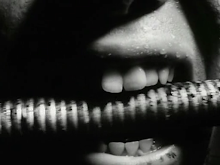
Michael Tolkin shone brilliantly with his delirious, insatiably experimental screenplay "The Player," (adapted from his novel of the same name) which used a big name movie producer to exemplify the worst of material excess and Hollywood ego. Robert Altman's film plays as a descent from a high-flying career into the darkest depths of human emotion, then into a sort of failed rebound, but inevitably back into pained realization. It was a unique, fully-immersive show biz satire that was topped only by David Lynch's masterful couplet of "Mulholland Dr." and "Inland Empire."
For his first feature film "The Rapture," Tolkin picked hot-topic religious issues as his springboard for cultural and social criticisms. Right off the bat, he picked a steep hill to climb. Religiously-themed movies, regardless of what they say or how they say it, are almost guarunteed to be contoversial. The title refers to the concept of fundamental Christian ideology that God's second coming is edging closer, and Tolkin's film is a fearless study of the truth of such beliefs in physical and metaphysical planes of existence. Unlike "The Player," which ends its arc at the disintegration of its character's inevitable guilt, "The Rapture" explores the process of redemption and the undoings of our own beliefs.
"The Rapture" starts out with a numb, floating longshot through the dark cubicle of an L.A. telephone operator service - cleverly addressing the theme of modern alienation with haunting, Ballardian coldness. We're introduced to Sharon (Mimi Rogers), who deals with her void of existential emptiness through group sex. In one of her escapades, she meets Randy, (David Duchovony) a carpenter who has less a void to fill as he has guilt to escape. He confides in her about a murder he dumbly committed for a thousand bucks, and that has followed him painfully ever since. After a series of chance encounters with religion, Rapture imagery (including a white pearl tattooed on a member of one of her swinger excersions), and her own demons, she decides to be saved.
My favorite scene in the movie is an argument Sharon has with Randy about her newly found beliefs. Randy believes there is no God but one which confused, pained people create for themselves. He represents a classic argument agaisnt spirituality in saying that "Some people do heroin, others do God" to avoid the inherent darkness of our lives. Sharon's defenses reveal her desperate need to believe in a spiritual identity.
The film uses the conversion of Sharon and, eventually, Randy to explore the functionality of extreme spiritual beliefs in modern society. Sharon delves so deeply into her community of fellow believers that she completely rejects the physical world she once belonged to which led her so far down the wrong path. This is a common occurance in "saved" Christians, who see their conversion as a total rebound from the empty lives they previously led. While not judging this mentality, Tolkin does show how such conversions can be equal parts rejuvenating and dangerous.
But then comes the ending - one so unbelievable and shocking that it almost needs to be watched twice. Tolkin boldly depicts the actual Rapture using conventional imagery (and very poor special effects) to end the film jarringly, but bravely. The film's resolution could have come from a Biblical parable, and it very well might have. The simplicity of the film's conclusion is provacative, but doesn't work very well. However, the movie as a whole is hard to evaluate as good or bad, right or wrong because it is both meditative and explanatory. For that reason, it represents the argument of spirituality in its own flaws.
What Tolkin was trying to say is hard to tell, and he absolutely intended it to be that way. The film is not defense for fundamentalist beliefs, but a statement about acceptance and openness. It opens so many doors of argument only to close them with a seemingly decisive ending. An equally interesting, but more effective film is William Friedkin's "Bug" which presents the similar madness of human emptiness and the possible dangers of our own beliefs. Its conclusion is just as provocative, but less open to interpretation and more direct.





